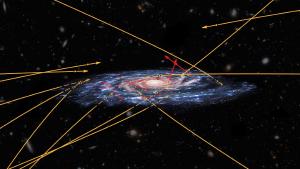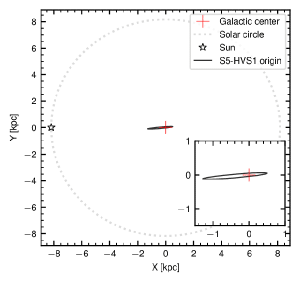Blog
Up and Away
14 November 2019
 NASA/ESA/Hubble/Marchetti et al.
NASA/ESA/Hubble/Marchetti et al.Our Sun speeds around the galaxy at about 230 kilometers per second. While that might seem fast, it’s a pretty common speed for a star. Most nearby stars move at a similar speed, taking about 250 million years to orbit the galaxy. But recently astronomers have discovered a star moving nearly twelve times faster than the Sun.1 The star, known as S5-HVS1, moves at nearly six million kilometers per hour. At such a tremendous speed it will eventually leave the galaxy and travel through intergalactic space, never to return.
A few high-velocity stars such as S5-HVS1 have been discovered before, and they raise the question of just how these stars came to move so quickly. One popular idea is that stars can gain speed by a close approach to our galaxies supermassive black hole.
 Sergey Koposov
Sergey KoposovIn our solar system, we often give spacecraft the speed necessary to reach the outer solar system by having them pass close to a planet. It’s known as the flyby effect, where the gravitational tug of the planet gives the spacecraft a boost of speed. A similar effect could work with a star. If a star happens to move close to the black hole in just the right way, it could be flung out of the galaxy with tremendous speed.
But proving this idea has been difficult. Most of the high-velocity stars we have observed are distant from the Earth, making it hard to determine its precise path. In contrast, S5-HVS1 is relatively close, only 29,000 light-years away. So astronomers were able to determine its path and determine where it came from. With a high degree of certainty, the star came from the region near our supermassive black hole.
Computer simulations also show how the close approach could have worked. If S5-HVS1 were once part of a binary system, a close approach to the black hole could have separated the stars. S5-HVS1 would have been given its tremendous speed, while its partner would have been captured by the black hole.
Regardless of the specific mechanism, it is clear that the supermassive black hole in our galactic center sent S5-HVS1 on its way. Having survived a close encounter, the star is now destined to leave our galaxy forever.
Koposov, Sergey E., et al. “Discovery of a nearby 1700 km/s star ejected from the Milky Way by Sgr A.” Monthly Notices of the Royal Astronomical Society (2019). ↩︎